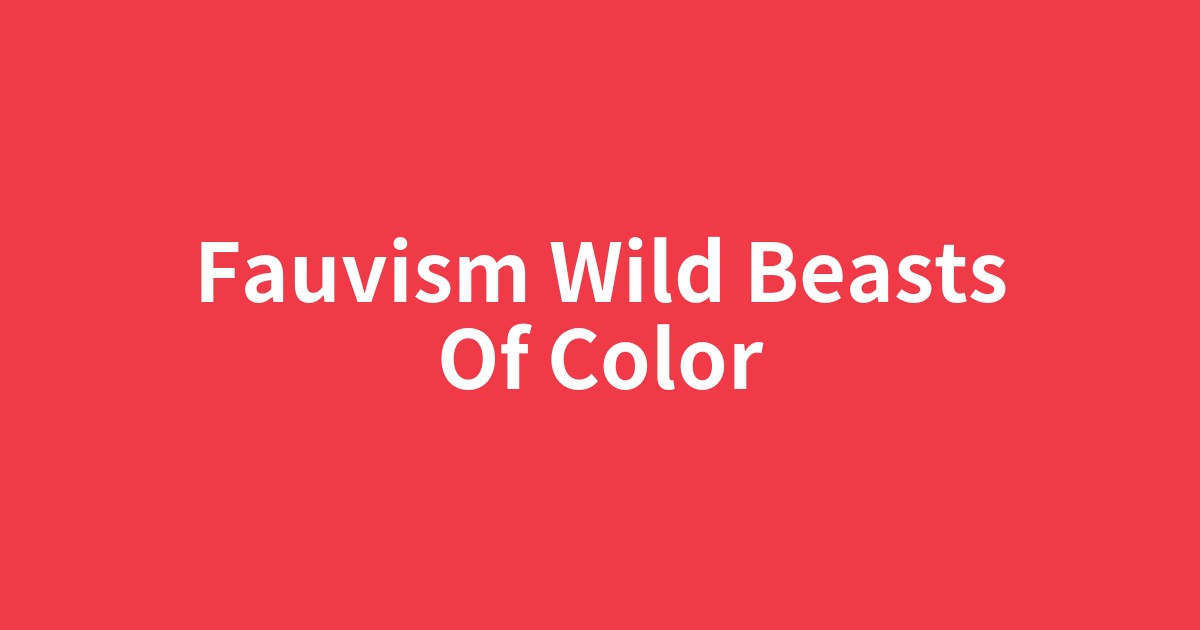このページは、歴史や文化の物語を楽しみながら、その文脈の中で重要な英単語を自然に学ぶための学習コンテンツです。各セクションの下にあるボタンで、いつでも日本語と英語を切り替えることができます。背景知識を日本語で学んだ後、英語の本文を読むことで、より深い理解と語彙力の向上を目指します。

「見たままの色」から解放され、心が感じるままに強烈な色彩を使ったマティスたち。批評家に「野獣(フォーヴ)」と呼ばれた、その大胆なexperiment(実験)。
この記事で抑えるべきポイント
- ✓フォーヴィスムは、対象を写実的に描くための「見たままの色」から芸術を解放し、画家の内面や感情を表現するための「純粋な色彩」を大胆に用いた、20世紀初頭の革新的な芸術運動であったとされています。
- ✓「フォーヴ(野獣)」という名称は、1905年のサロン・ドートンヌに出品されたアンリ・マティスらの作品が、そのあまりに強烈な色彩から批評家ルイ・ヴォークセルによって揶揄されたことに由来するという逸話があります。
- ✓伝統的な遠近法やデッサンを簡略化し、荒々しい筆致と原色に近い色面を組み合わせることで、理屈ではなく感覚や感情に直接訴えかける表現を追求した点が特徴的であると考えられています。
- ✓短い期間の運動でしたが、色彩を感情表現の主要な手段とする考え方は、後のドイツ表現主義をはじめとする20世紀の様々な芸術動向に大きな影響を与えたと評価されています。
フォーヴィスム ― 色彩の「野獣」たちの革命
もし、空を黄色で、人の顔を緑で描いた絵があったら、あなたはどう感じますか? 20世紀初頭、伝統と格式を重んじるパリの美術界に、まさにそのような絵画で殴り込みをかけた若者たちがいました。彼らは批評家から侮蔑を込めて「野獣(フォーヴ)」と呼ばれました。この記事では、彼らが美術史にどのような革命(revolution)をもたらしたのか、その鮮烈な軌跡を追っていきましょう。
Fauvism: The Revolution of the Colorful "Wild Beasts"
If you saw a painting of a yellow sky and a green human face, how would you feel? At the beginning of the 20th century, a group of young artists stormed the art scene of Paris, a city that revered tradition and formality, with just such paintings. A critic contemptuously called them "Les Fauves" (The Wild Beasts). In this article, let's explore the revolution they brought to art history through their vivid journey.
「色彩の檻」からの脱出 ― 世紀末パリの芸術
フォーヴィスムが突如として生まれたわけではありません。その土壌は、19世紀末の芸術家たちによって着々と耕されていました。印象派が光の変化を捉えるために色彩を分割すれば、ゴッホやゴーギャンといったポスト印象派の画家たちは、さらに一歩進んで、内面の表現のために色彩を用いました。彼らの様々な芸術的実験(experiment)は、来るべき新しい世紀の芸術家たちに大きな勇気を与えたのです。伝統的な価値観が揺らぎ、新しい時代への期待と不安が渦巻く世紀末のパリ。芸術家たちは、客観的な(subjective)現実を写し取るだけではない、新たな表現の可能性を模索していました。
Escape from the "Cage of Color": Art in Fin-de-Siècle Paris
Fauvism did not emerge out of nowhere. The groundwork was steadily laid by artists of the late 19th century. While the Impressionists broke down color to capture changes in light, Post-Impressionists like Van Gogh and Gauguin took it a step further, using color to express their inner worlds. Their various artistic experiments gave great courage to the artists of the coming new century. In fin-de-siècle Paris, where traditional values were wavering and a mix of anxiety and anticipation for a new era swirled, artists were searching for new expressive possibilities beyond merely depicting objective reality.
1905年、サロン・ドートンヌ事件 ― 「野獣」誕生の瞬間
1905年、パリで開かれた秋の公募展「サロン・ドートンヌ」で事件は起こりました。アンリ・マティスやアンドレ・ドランらが出品した一室は、あまりにも目に焼き付くような色彩で溢れかえっていました。赤、青、緑、黄色といった原色が、荒々しい筆致でキャンバスに叩きつけられていたのです。この部屋の中央には、伝統的な様式の穏やかな彫刻が置かれていました。その異様な光景を目の当たりにした批評家ルイ・ヴォークセルは、「ドナテッロが野獣(beast)の檻の中にいるようだ」と揶揄したと言われています。この痛烈な批評が、彼らの代名詞「フォーヴ(野獣たち)」の起源となったのです。この展覧会は一大スキャンダル(scandal)となり、保守的な人々からは非難囂々でしたが、その衝撃こそが、無名の若き画家たちの名を一躍パリ中に知らしめることになりました。
The 1905 Salon d'Automne Affair: The Birth of the "Wild Beasts"
The incident occurred in 1905 at the Salon d'Automne, an autumn exhibition in Paris. A room featuring works by Henri Matisse, André Derain, and others was overflowing with colors so vivid they seemed to burn into the eyes. Primary colors like red, blue, green, and yellow were dashed onto the canvases with rough brushstrokes. In the center of this room stood a serene, traditionally styled sculpture. Witnessing this bizarre scene, the critic Louis Vauxcelles is said to have derisively remarked, "Donatello au milieu des fauves" (Donatello among the wild beasts). This scathing critique gave birth to their moniker, "Les Fauves." The exhibition became a major scandal, drawing condemnation from conservative circles, but it was this very shock that propelled the names of these unknown young painters to fame throughout Paris.
心が感じるままに ― 色彩と感情のliberation(解放)
フォーヴィスムの核心とは何だったのでしょうか。それは、一言で言えば「色彩の解放(liberation)」です。彼らにとって、色はもはや対象の固有色を再現するための道具ではありませんでした。リンゴは赤く、空は青くなくてもよかったのです。色は、画家の主観的な(subjective)感情(emotion)を鑑賞者に直接伝えるための、それ自体が力を持つ表現要素でした。この思想を実現するため、彼らは伝統的な遠近法や精緻なデッサンを大胆に放棄し、形態を単純化しました。その表現は、一部の人々からは未熟で原始的(primitive)だと評されましたが、彼らが目指したのは理屈による理解ではなく、チューブから絞り出したままのような強烈な(intense)色彩がもたらす、感覚への直接的な訴えかけだったのです。
As the Heart Feels: The Liberation of Color and Emotion
What was the core of Fauvism? In a word, it was the liberation of color. For these artists, color was no longer a tool for reproducing the inherent colors of an object. An apple didn't have to be red, nor the sky blue. Color was an expressive element in its own right, a force for directly conveying the artist's subjective emotion to the viewer. To realize this idea, they boldly abandoned traditional perspective and detailed drawing, simplifying forms. Their expression was deemed immature and primitive by some, but their goal was not intellectual understanding. Instead, they aimed for a direct appeal to the senses, delivered by intense colors that looked as if they were squeezed straight from the tube.
短い輝きと、その後のimpact(影響)
意外なことに、「フォーヴィスム」という運動がグループとして明確な形を持っていたのは、1905年からわずか数年間のことでした。画家たちはやがてそれぞれの個性を深め、異なる道を歩んでいきます。しかし、この短い輝きが後世の芸術に与えた影響(impact)は計り知れません。特に、色彩を感情表現の主要な手段とする考え方は、ドイツ表現主義の画家たちに直接的なインスピレーションを与えました。そして、対象を描くことから完全に離れ、色と形だけで構成される抽象絵画の誕生へと繋がる道を切り開いたのです。フォーヴィスムは、20世紀美術の扉をこじ開けた、重要な鍵の一つでした。
A Brief Brilliance and Its Lasting Impact
Surprisingly, the "Fauvism" movement as a distinct group lasted for only a few years after 1905. The artists soon went their separate ways, each developing their own individual style. However, the impact of this brief brilliance on later art is immeasurable. In particular, the idea of using color as the primary means of emotional expression directly inspired the German Expressionists. It also paved the way for the birth of abstract painting, which moved away from depicting objects entirely to be composed of just color and form. Fauvism was one of the crucial keys that unlocked the door to 20th-century art.
結論:常識を塗り替えた色彩の革命
フォーヴィスムは、単なる過激で一時的な流行ではありませんでした。それは、芸術家が「見たまま」の世界の束縛から自らを解き放ち、「感じるまま」に表現する自由を勝ち取った、美術史における偉大な革命(revolution)でした。彼らの大胆な試みは、100年以上を経た現代の私たちにも、力強く語りかけているように思えます。常識という名の「色の見本帳」に捉われず、自分自身の感覚を信じることの価値を。あなたの目には今、世界はどんな色に映っているでしょうか。
Conclusion: A Revolution of Color That Redefined Convention
Fauvism was not merely a radical, fleeting trend. It was a great revolution in art history, where artists freed themselves from the constraints of the "as-seen" world and won the freedom to express themselves "as-felt." Their bold endeavors seem to speak powerfully to us today, over a century later, about the value of trusting our own senses, unbound by the color chart of convention. In what colors does the world appear to your eyes right now?